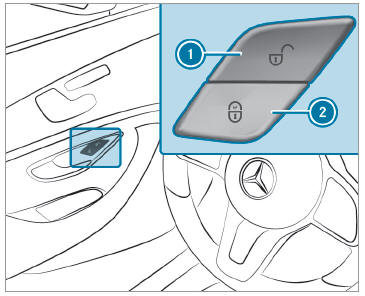Mercedes-Benz GLC : Data processing in the vehicle / Operational data in the vehicle
This is data regarding the operation of the vehicle, which have been processed by control units.
This includes the following data, for example:
- Vehicle status information such as the speed, longitudinal acceleration, lateral acceleration, number of wheel revolutions or the fastened seat belts display
- Ambient conditions, such as temperature, rain sensor or distance sensor
Generally, the use of these data is temporary; they will not be stored beyond the period of operation and will only be processed within the vehicle itself. Control units often contain data memories for vehicle keys, for example. Their use permits the temporary or permanent documentation of technical information about the vehicle's operating state, component loads, maintenance requirements and technical events or malfunctions.
Depending on the vehicle equipment, the following data are stored:
- Operating status of system components, such as fill levels, tire pressure or battery status
- Malfunctions or faults in important system components, such as lights or brakes
- System reactions in special driving situations, such as airbag deployment or the intervention of stability control systems
- Information on events leading to vehicle damage
In certain cases, it may be required to store data that would have otherwise been used only temporarily. This may be the case if the vehicle has detected a malfunction, for example.
If you use services, such as repair services and maintenance work, stored operational data as well as the vehicle identification number can be read out and used. They can be read out by service network employees, such as workshops and manufacturers or third parties, such as breakdown services. The same is true in the case of warranty claims and quality assurance measures.
In general, the read out is performed via the legally prescribed port for the diagnostics connection in the vehicle. The operational data that are read out document technical states of the vehicle or of individual components and assist in the diagnosis of malfunctions, compliance with warranty obligations and quality improvement. To that end, these data, in particular information about component loads, technical events, malfunctions and other faults may be transmitted along with the vehicle identification number to the manufacturer. Furthermore, the manufac turer is subject to product liability. For this reason the manufacturer also uses operational data from the vehicle, for example, for recalls. These data can also be used to examine the customer's warranty and guarantee claims.
Fault memories in the vehicle can be reset by a service outlet or at your request as part of repair or maintenance work.
 Legal requirements regarding the disclosure of data
Legal requirements regarding the disclosure of data
If legally required to do so, manufacturers are, in
individual cases, legally obliged to provide governmental
entities, upon request and to the
extent required, data stored by the manufacturer...
 Convenience and infotainment functions
Convenience and infotainment functions
You can store convenience settings and individual
settings in the vehicle and change or reset
them at any time.
Depending on the vehicle equipment, this
includes the following settings, for example:
Seat and steering wheel positions
Suspension and climate control settings
Individual settings, such as interior lighting
Depending on the selected equipment, you can
import data into vehicle infotainment functions
yourself...
Other information:
Mercedes-Benz GLC 2016-2026 Owners Manual: Notes on cleaning decorative foils
Observe the notes on matte finish care in the chapter "Notes on paintwork/matte finish paintwork care". They also apply to matte decorative foils. Observe the notes on cleaning decorative foils to avoid vehicle damage. Cleaning For cleaning, use plenty of water and a mild cleaning agent without additives or abrasive substances, e...
Mercedes-Benz GLC 2016-2026 Owners Manual: Overview of buttons on the steering wheel
..

